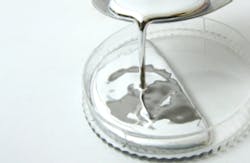Contaminant of the Month: Mercury
What it is:
- Mercury (Hg) is a silvery metal with a melting point of -39o C, so it is a liquid under normal conditions.
- Its atomic number is 80 and its atomic weight is 200.59 daltons.
- Its specific gravity is 13.59 times water’s.
- It is found in cinnabar ore as mercuric sulfide primarily on the Iberian Peninsula. Heating the oxide to 500o C produces metallic mercury that distills out.
- It forms a variety of organic and inorganic compounds, including Hg+1 and Hg+2 salts, oxides and sulfides, as well as organometallic compounds like dimethylmercury and methylmercuric chloride, and complexes with amines.
- Mercury and its compounds have many commercial and industrial uses. The metal has been used in thermometers and barometers and as a seal in some electrical switches.
- The salts have been used as biocides. Until 1991, interior latex paints commonly contained mercuric fungicides. It is also used in dental amalgams.
- Mercury and its compounds are mobile, and they enter the environment from combustion of fossil fuels and biological processes producing alkyl mercury compounds that are much more toxic than the salts and elemental mercury.
Occurrence:
- Mercury is present in the Earth’s crust at only about 6.7 x 10-6 percent.
- Uses have been decreasing due to toxicity and environmental concerns.
- Drinking water is a minor source of exposure. Mercury was found in only 42 of 989 groundwaters used for drinking water in the 1988 National Inorganics Reconnaissance Survey; 26 were detected below 0.2 µg/l, and one exceeded 2 µg/l.
- Concentrations in air range from 2 to 10 ng/m3.
- Food is the principal source of exposure primarily from fish and fish products. Larger fish, e.g., tuna and swordfish, have higher quantities since they feed on smaller fish and bioaccumulate mercury.
- Inorganic mercury can be converted to organic forms by bacteria in sediments, and when suspended, they accumulate in fish.
- Dietary exposure estimates are approximately 2 to 20 µg/day but can be greater depending upon dietary preferences and locations.
Health effects:
- About eight percent of mercury ingested in food is absorbed verses about 15 percent from water. About 80 percent of inhaled metallic mercury is absorbed.
- The biological half-life of mercury is counted in years with elimination in urine and feces.
- The kidney is the primary organ where mercury accumulates and causes toxicity. Organomercurials are much more toxic than inorganic forms.
- Inhaled mercury is neurotoxic. The Mad Hatter in "Alice in Wonderland" was probably suffering from mercury exposure in his leather-processing occupation.
Analyses:
- ICP-MS (inductively coupled – plasma mass spectrometry) can achieve at least 0.6 µg/l, and atomic absorption is also capable to achieve less than 1 µg/l.
Water treatment:
- Conventional coagulation, sedimentation and filtration can remove about 80 percent of inorganic mercury and about 30 percent of organic mercury.
- Powdered activated carbon (PAC) and granular activated carbon (GAC) carbons are effective for both forms so POU and POE devices can be applied.
- Cation exchange is also a possible treatment.
Regulation:
- The U.S. Environmental Protection Agency (EPA) drinking water MCL for inorganic mercury is 2 µg/l (0.002 mg/l). The one-day and 10-day Health Advisories are conservatively also 2 µg/l.
- The World Health Organization (WHO) drinking water guideline is 6 µg/l.
Dr. Cotruvo is president of Joseph Cotruvo and Associates, LLC, Water, Environment and Public Health Consultants. He is a former director of the U.S. EPA Drinking Water Standards Division.
